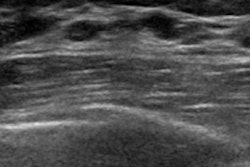
Supplemental screening ultrasound shows a mixed performance in women with a personal history of breast cancer, with lower sensitivity and a higher interval cancer rate. But the modality also had higher specificity, according to a study published online February 25 in Radiology.
The findings suggest that the quest for effective ways to follow breast cancer survivors continues, wrote a team led by Dr. Soo-Yeon Kim, PhD, of Seoul National University Hospital in South Korea.
"Further research is needed to more accurately identify women who will benefit from supplemental ultrasound screening," the group wrote.
Breast cancer survivors are more vulnerable to developing second cancers, and they are tracked carefully with regular imaging. But mammography has shown lower sensitivity and higher interval cancer rates in women with a history of the disease compared with those without, Kim and colleagues noted.
Breast MRI is recommended for screening women at high risk of breast cancer, but it has its downsides, including high cost and the need for a contrast agent. Because screening breast ultrasound is readily available, doesn't require contrast, and is cost-effective, interest in using it to track breast cancer survivors has increased.
Kim and colleagues compared the performance of screening breast ultrasound between women with and without personal history of breast cancer. Their study included 3,226 breast cancer survivors and 3,226 women without history of the disease, all of whom underwent supplemental breast ultrasound and mammography between January and December 2013. The women were matched by age and breast density.
Fourteen cancers were identified among the breast cancer survivors (six on screening, eight interval) and 13 among the women with no personal history of the disease (12 on screening, one interval). Supplemental ultrasound's performance among the two groups of women varied.
| Performance of supplemental screening ultrasound | |||
| Performance measure | Women with no personal history of breast cancer | Breast cancer survivors | p-value |
| Abnormal interpretation rate | 11% | 7.3% | < 0.001 |
| Biopsy rate | 1.8% | 1.2% | 0.04 |
| Interval cancer rate per 1,000 women | 0.3 | 2.5 | 0.02 |
| Sensitivity | 92% | 43% | 0.03 |
| Specificity | 89.3% | 92.8% | < 0.001 |
"The low sensitivity and high interval cancer rate in women with a personal history of breast cancer imply that limited sensitivity of mammography in these women might have not been fully overcome by supplemental ultrasound," Kim and colleagues wrote. But, "regarding false-positive findings, supplemental ultrasound in women with a personal history of breast cancer showed lower abnormal interpretation rates, lower biopsy rates, and higher specificity than in women without a personal history of breast cancer."
It's clear that more research is necessary to determine how best to track breast cancer survivors, wrote Drs. Christoph Lee and Janie Lee, both of the University of Washington in Seattle, in an accompanying editorial.
"Additional studies are needed in larger and more diverse settings to better define the benefits and harms of supplemental screening among women with a previous history of breast cancer," they wrote.




















